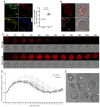Dynamics of Mitochondrial DNA Copy Number and Membrane Potential in Mouse Pre-Implantation Embryos: Responses to Diverse Types of Oxidative Stress
- PMID: 38540426
- PMCID: PMC10970549
- DOI: 10.3390/genes15030367
Dynamics of Mitochondrial DNA Copy Number and Membrane Potential in Mouse Pre-Implantation Embryos: Responses to Diverse Types of Oxidative Stress
Abstract
Mitochondria undergo a myriad of changes during pre-implantation embryo development, including shifts in activity levels and mitochondrial DNA (mtDNA) replication. However, how these distinct aspects of mitochondrial function are linked and their responsiveness to diverse stressors is not well understood. Here, we show that mtDNA content increased between 8-cell embryos and the blastocyst stage, with similar copy numbers per cell in the inner cell mass (ICM) and trophectoderm (TE). In contrast, mitochondrial membrane potential (MMP) was higher in TE than ICM. Culture in ambient oxygen (20% O2) altered both aspects of mitochondrial function: the mtDNA copy number was upregulated in ICM, while MMP was diminished in TE. Embryos cultured in 20% O2 also exhibited delayed development kinetics, impaired implantation, and reduced mtDNA levels in E18 fetal liver. A model of oocyte mitochondrial stress using rotenone showed only a modest effect on on-time development and did not alter the mtDNA copy number in ICM; however, following embryo transfer, mtDNA was higher in the fetal heart. Lastly, endogenous mitochondrial dysfunction, induced by maternal age and obesity, altered the blastocyst mtDNA copy number, but not within the ICM. These results demonstrate that mitochondrial activity and mtDNA content exhibit cell-specific changes and are differentially responsive to diverse types of oxidative stress during pre-implantation embryogenesis.
Keywords: inner cell mass; mitochondrial dysfunction; mitochondrial membrane potential; mtDNA copy number.
Conflict of interest statement
The authors declare no conflicts of interest.
Figures





References
Publication types
MeSH terms
Substances
Grants and funding
LinkOut - more resources
Full Text Sources

